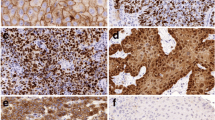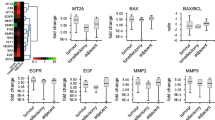Abstract
We tested the expression of known (p16ink4, Ki67, p53, EGFR) and a new immunohistochemical (collagen XVII/BP180) biomarker in head and neck squamous cell carcinomas (SCC) of diverse anatomical localization. Tissue microarrays (TMA) of 124 SCC were created, immunostained, and analyzed following whole slide digitalization using the Pannoramic Scan and the TMA Module software (3DHISTECH Kft, Budapest, Hungary). Statistical analysis of scoring results was carried out using Pearson’s chi-square test. We observed the significant elevation of p16ink4 and Ki67 expression in supraglottic, tonsillar and tonsillo-lingual SCCs compared to those affecting the oral cavity, oropharynx without tonsils, larynx without supraglottis and the hypopharynx. This differential antigen expression may reflect the diverse route of embryologic differentiation followed by the affected regions except those of the tonsils and the supraglottis which show similar antigenic pattern but diverse developmental path. All the other biomarkers tested including p53, collagen XVII and EGFR were detected in the majority of cancers including high grade cases, but did not reveal any significant regional difference. Based on our results oropharyngeal squamous cell carcinomas may not be regarded as one entity. Concerning the oral cavity and the oropharynx, cancers affecting the tonsils (palatine and lingual) show significantly elevated p16ink4 and Ki67 expression; so as the cancers of the supraglottis compared to the rest of larynx. Consequently, tonsillar and supraglottic cancers show similar biomarker profiles. Correlation of differential biomarker expression with diverse biological behavior in head and neck cancers need further investigations.


Similar content being viewed by others
Abbreviations
- Cdk:
-
Cyclin-dependent kinases
- CollXVII:
-
Collagen XVII/BP 180
- DAB:
-
Diamino-benzidine
- EDTA:
-
Ethylene diamino tetraacetic acid
- EGFR:
-
Epidermal growth factor
- HNSCC:
-
Head and Neck squamous cell carcinoma
- HPV:
-
Humanpapilloma virus
- Rb:
-
Retinoblastoma protein
- SCC:
-
Squamous cell carcinoma
- TBS:
-
Tris buffered saline
- TMA:
-
Tissue microarray
References
Répássy G, Cs F-H, Juhász A et al (1998) Expression of invasion markers CD44v6/v3, NM23 and MMP in laryngeal and hypopharyngeal carcinoma. Pathol Oncol Res 4:14–21
Lukits J, Timár J, Juhász A et al (2001) Progression difference between cancers of the larynx and hypopharynx is not due to tumor size and vascularization. Otolaryngol Head Neck Surg 125:18–22
Ang KK, Harris J, Wheeler R et al (2010) Human papillomavirus and survival of patients with oropharyngeal cancer. N Engl J Med 363:24–35
Dahlstrand H, Näsman A, Romanitan M et al (2008) Human papillomavirus accounts both for increased incidence and better prognosis in tonsillar cancer. Anticancer Res 28:1133–1138
Vidal L, Gillison ML (2008) Human papillomavirus in HNSCC: recognition of a distinct disease type. Hematol Oncol Clin North Am 22:1125–1142
Parry D, Bates S, Mann DJ et al (1995) Lack of cyclin D-Cdk complexes in Rb-negative cells correlates with high levels of p16INK4/MTS1 tumour suppressor gene product. EMBO J 14:503–511
Andl T, Kahn T, Pfuhl A et al (1998) Etiological involvement of oncogenic human papillomavirus in tonsillar squamous cell carcinomas lacking retinoblastoma cell cycle control. Cancer Res 58:5–13
Chung CH, Raben D (2010) p16 expression as a predictive biomarker of hypoxic cell-sensitizing agents in oropharyngeal. Cancer J Clin Oncol 27:4103–4104
Shi W, Kato H, Perez-Ordonez B et al (2009) Comparative prognostic value of HPV16 E6 mRNA compared with in situ hybridization for human oropharyngeal squamous carcinoma. J Clin Oncol 27:6213–6221
Kong CS, Narasimhan B, Cao H et al (2009) The relationship between human papillomavirus status and other molecular prognostic markers in head and neck squamous cell carcinomas. Int J Radiat Oncol Biol Phys 74:553–561
Stelkovics E, Korom I, Marczinovits I et al (2008) Collagen XVII/BP180 protein expression in squamous cell carcinoma of the skin detected with novel monoclonal antibodies in archived tissues using tissue microarrays and digital microscopy. Appl Immunohistochem Mol Morphol 16:433–441
Nilsson K, Svensson S, Landberg G (2004) Retinoblastoma protein function and p16INK4a expression in actinic keratosis, squamous cell carcinoma in situ and invasive squamous cell carcinoma of the skin and links between p16INK4a expression and infiltrative behavior. Mod Pathol 17:1464–1474
Ai L, Stephenson KK, Ling W et al (2003) The p16 (CDKN2a/INK4a) tumor-suppressor gene in head and neck squamous cell carcinoma: a promoter methylation and protein expression study in 100 cases. Mod Pathol 16(9):944–950
Weinberger PM, Yu Z, Haffty BG et al (2004) Prognostic significance of p16 protein levels in oropharyngeal squamous cell cancer. Clin Cancer Res 10(17):5684–5691
Aebersold DM, Beer KT, Laissue J et al (2000) Intratumoral microvessel density predicts local treatment failure of radically irradiated squamous cell cancer of the oropharynx. Int J Radiat Oncol Biol Phys 48:17–25
Sittel C, Eckel HE, Damm M et al (2000) Ki67 (MIB1), p53, and lewis-X (LeuM1) as prognostic factors of recurrence in T1 and T2 laryngeal carcinoma. Laryngoscope 110:1012–1017
Somers KD, Merrick MA, Lopez ME et al (1992) Frequent p53 mutations in head and neck cancer. Cancer Res 52(21):5997–6000
Bradford CR, Zhu S, Ogawa H et al (2003) P53 mutation correlates with cisplatin sensitivity in head and neck squamous cell carcinoma lines. Head Neck 25(8):654–661
Cabelguenne A, Blons H, de Waziers I et al (2000) p53 alterations predict tumor response to neoadjuvant chemotherapy in head and neck squamous cell carcinoma: a prospective series. J Clin Oncol 18(7):1465–1473
Temam S, Flahault A, Périé S et al (2000) p53 gene status as a predictor of tumor response to induction chemotherapy of patients with locoregionally advanced squamous cell carcinomas of the head and neck. J Clin Oncol 18(2):385–394
Ang KK, Berkey BA, Tu X et al (2002) Impact of epidermal growth factor receptor expression on survival and pattern of relapse in patients with advanced head and neck carcinoma. Cancer Res 62(24):7350–7356
Kalyankrishna S, Grandis JR (2006) Epidermal growth factor receptor biology in head and neck cancer. J Clin Oncol 24(17):2666–2672
Grandis JR, Melhem MF, Gooding WE et al (1998) Levels of TGF-alpha and EGFR protein in head and neck squamous cell carcinoma and patient survival. J Natl Cancer Inst 90(11):824–832
Eberhard DA, Johnson BE, Amler LC et al (2005) Mutations in the epidermal growth factor receptor and in KRAS are predictive and prognostic indicators in patients with non-small-cell lung cancer treated with chemotherapy alone and in combination with erlotinib. J Clin Oncol 23(25):5900–5909
Peták I, Schwab R, Orfi I et al (2010) Integrating molecular diagnostics into anticancer drug discovery. Nat Rev Drug Discov 7:523–535
Répássy G, Czigner J, Ribári O et al (1988) The barrier-like role of activated connective tissue against the spread of supraglottic laryngeal carcinoma. Arch Otorhinolaryngol 245:151–154
Acknowledgements
We thank to István Gaudi for the excellent statistical analysis (Department of Epidemiology, National Institute of Oncology, Budapest, Hungary).
Author information
Authors and Affiliations
Corresponding author
Rights and permissions
About this article
Cite this article
Tamás, L., Szentkúti, G., Erős, M. et al. Differential Biomarker Expression in Head and Neck Cancer Correlates with Anatomical Localization. Pathol. Oncol. Res. 17, 721–727 (2011). https://doi.org/10.1007/s12253-011-9376-9
Received:
Accepted:
Published:
Issue Date:
DOI: https://doi.org/10.1007/s12253-011-9376-9




